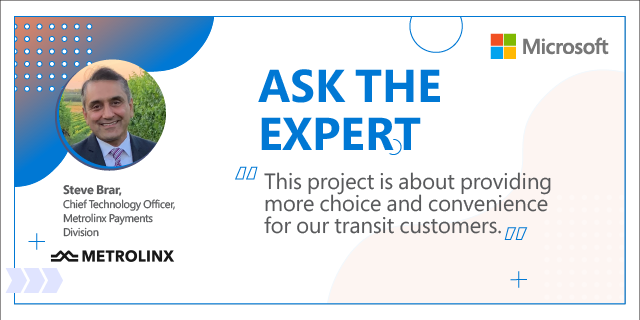By Lisa Carroll, Public Sector Lead, Microsoft Canada
Our “Ask the Expert” series features notable public sector leadership voices to share insights about how their organizations are embracing new technology to improve operations and become future-ready. In this installment, we’re featuring Metrolinx.
Metrolinx is an agency of the Government of Ontario responsible for managing transportation infrastructure and services for the Greater Toronto and Hamilton Area (GTHA) and the City of Ottawa. Since its inception, Metrolinx has made great strides towards making transportation around the GTHA more seamless. A major milestone includes introducing PRESTO, the one fare card system, across all modes of transportation.
To build on this success and provide even more flexible fare options, Metrolinx embarked on the next phase of their digital transformation journey to make open payments a reality. To share more, we’re joined by Steve Brar, CTO at Metrolinx Payments Division.
Can you describe the open payments project at Metrolinx and what led to its inception?
For a while, riders have been requesting open payments, so we wanted to deliver on this and round out our payment offering. This project is about providing more choice and convenience for our transit customers. The solution now enables riders to use their credit card or debit card to tap on and off transit across our regional transit agencies – including TTC, GO Transit, MiWay (Mississauga) and Up Express. Microsoft Azure is powering an industry leading real-time fare management system, and also on the back end by enabling Power BI to assist with our data and analytics.
Were there any unique challenges that you faced when implementing this new technology?
When it comes to transit, posting an open payment charge on a credit or debit card is a little more sophisticated compared to a regular retail transaction. Our requirements include processing 40-50 taps per minute on each device, and due to the timeliness of transit – this needs to happen quickly. You can imagine being in line waiting to tap to catch your train or bus – there can’t be a delay. This aggressive response time was a hurdle that we needed to overcome.
In terms of the rollout, the payments platform was first rolled-out in the greater Toronto area and then across the TTC. The time-consuming part for TTC was physically rolling out the new payment readers and inspection devices that recognize the new payment methods and stress testing the system, due to both the scale of our transit network and it being critical public infrastructure, ensuring high quality, stability and reliability. You may have noticed them in your local transit stations now.
Now that you’ve completed a successful roll out of open payments (no small feat!) what will be your focus?
We started designing the account-based ticketing system for open payments back in 2019, so it’s been a process. At this phase in the project our priorities will be ensuring a smooth and secure experience for our transit riders. When processing so many payments across our transit network, security is a top priority. This is why we were keen to take advantage of the great umbrella that Microsoft provides from a security perspective. By using this system, we have confidence that all sensitive information is secure and protected.




